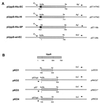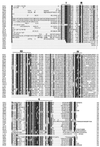Use of genomics to identify bacterial undecaprenyl pyrophosphate synthetase: cloning, expression, and characterization of the essential uppS gene
- PMID: 9882662
- PMCID: PMC93402
- DOI: 10.1128/JB.181.2.483-492.1999
Use of genomics to identify bacterial undecaprenyl pyrophosphate synthetase: cloning, expression, and characterization of the essential uppS gene
Abstract
The prenyltransferase undecaprenyl pyrophosphate synthetase (di-trans,poly-cis-decaprenylcistransferase; EC 2.5.1.31) was purified from the soluble fraction of Escherichia coli by TSK-DEAE, ceramic hydroxyapatite, TSK-ether, Superdex 200, and heparin-Actigel chromatography. The protein was labeled with the photolabile analogue of the farnesyl pyrophosphate analogue (E, E)-[1-3H]-(2-diazo-3-trifluoropropionyloxy)geranyl diphosphate and was detected on a sodium dodecyl sulfate-polyacrylamide gel as a protein with an apparent molecular mass of 29 kDa. This protein band was cut out from the gel, trypsin digested, and subjected to matrix-assisted laser desorption ionization mass spectrometric analysis. Comparison of the experimental data with computer-simulated trypsin digest data for all E. coli proteins yielded a single match with a protein of unassigned function (SWISS-PROT Q47675; YAES_ECOLI). Sequences with strong similarity indicative of homology to this protein were identified in 25 bacterial species, in Saccharomyces cerevisiae, and in Caenorhabditis elegans. The homologous genes (uppS) were cloned from E. coli, Haemophilus influenzae, and Streptococcus pneumoniae, expressed in E. coli as amino-terminal His-tagged fusion proteins, and purified over a Ni2+ affinity column. An untagged version of the E. coli uppS gene was also cloned and expressed, and the protein purified in two chromatographic steps. We were able to detect Upp synthetase activity for all purified enzymes. Further, biochemical characterization revealed no differences between the recombinant untagged E. coli Upp synthetase and the three His-tagged fusion proteins. All enzymes were absolutely Triton X-100 and MgCl2 dependent. With the use of a regulatable gene disruption system, we demonstrated that uppS is essential for growth in S. pneumoniae R6.
Figures







References
-
- Adair W L, Cafmeyer N, Keller R K. Solubilization and characterization of the long chain prenyltransferases involved in dolichyl phosphate biosynthesis. J Biol Chem. 1984;259:4441–4446. - PubMed
-
- Allen C M, Keenan M V, Sack J. Lactobacillus plantarum undecaprenyl pyrophosphate synthetase: purification and reaction requirements. Arch Biochem Biophys. 1976;175:236–248. - PubMed
-
- Allen C M, Muth J D. Lipid activation of undecaprenyl pyrophosphate synthetase from Lactobacillus plantarum. Biochemistry. 1977;16:2908–2915. - PubMed
-
- Allen C M. Purification and characterization of undecaprenyl-pyrophosphate synthetase. Methods Enzymol. 1985;110:281–299. - PubMed
-
- Asai K, Fujisaki S, Nishimura Y, Nishino T, Okada K, Nakagawa T, Kawamukai M, Matsuda H. The identification of E. coli ispB (cel) gene encoding the octaprenyl diphosphate synthase. Biochem Biophys Res Commun. 1994;202:340–345. - PubMed
Publication types
MeSH terms
Substances
Associated data
- Actions
- Actions
Grants and funding
LinkOut - more resources
Full Text Sources
Other Literature Sources
Molecular Biology Databases

